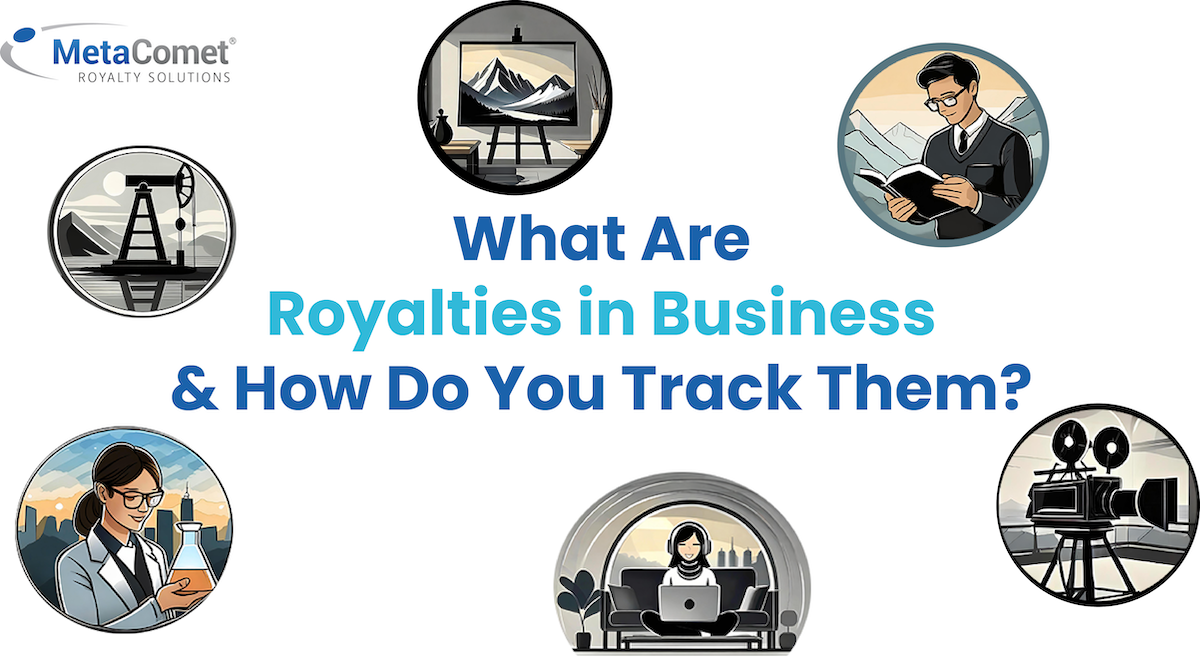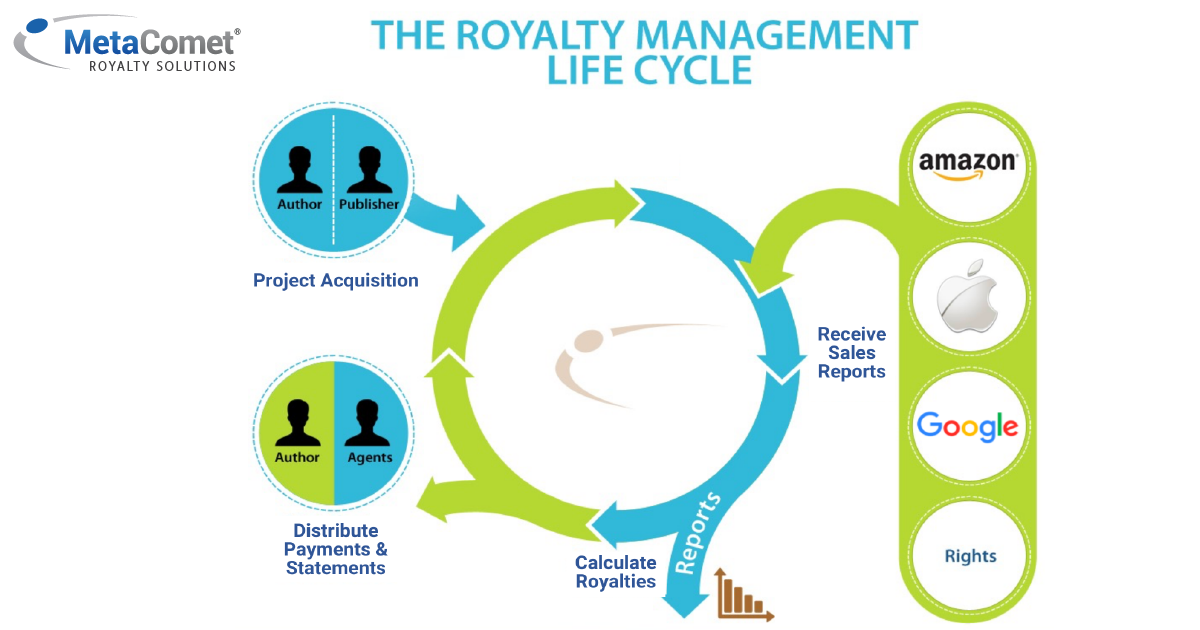No Results Found
The page you requested could not be found. Try refining your search, or use the navigation above to locate the post.
The page you requested could not be found. Try refining your search, or use the navigation above to locate the post.
Authors, illustrators, inventors, and developers — these diverse types of professionals are among the many who create intellectual property and rely on royalty payments to support their work. Publishers, manufacturers, distributors, and other businesses license these creations, generate revenue, and then need to calculate, pay, and track royalties accordingly.
It’s critical for all parties in royalty-related businesses to have a firm understanding of how royalties work, to agree on the variables that factor into their royalty arrangements, and to have a transparent view of how royalties are calculated.
This article presents common factors in royalty calculations, information that needs to be tracked and shared throughout the royalty process, and solutions for simplifying and streamlining the potentially complex management of royalties in business.

To help illustrate, consider the publishing industry. Publishing royalties are a payment structure in which an author earns a percentage of book sales, as agreed upon when the work is licensed to a publisher. This contrasts with a “work for hire” model, in which the publisher fully owns the content. The royalty model allows both parties to share the financial risks and potential rewards, with authors standing to gain more if the book is successful.
In addition to the book publishing business, royalties may also be employed in other businesses that involve the licensing of copyrights, patents, and trademarks, such as music, video content, software, art, characters, brands, pharmaceuticals, medical devices, other technology, and franchises, and even in the licensing of natural resources from a landowner.
In other words, when a property owner, or licensor, makes an agreement to allow a licensee to use the licensor’s property to generate revenue, the two parties will often agree on revenue-dependent royalty terms, rather than a flat payment of set fees.
There are virtually an infinite number of ways to set up a royalty agreement. The people involved in formulating the deal can be as creative in their agreements as they wish. Yet there are some common practices within certain industries.
Sometimes the royalty terms are based on the type of product being sold. Royalties for various digital products are likely to depend on format, such as streaming or downloadable audio or video, ebook, whether it’s distributed as part of a subscription, or other.
When licensing intellectual property for physical products, the royalty frameworks may be even more varied, based on the types of products, costs of the products, and whether there are other licensed components integrated within that product.
Sometimes royalties can be based on the sales channel: whether it’s sold online or through a physical retail outlet.
The region in which the product is sold can also be a factor in royalty terms, and all of the above variables may be mixed and matched within a single agreement.
Royalty calculations are typically based on a percentage of either the sale price or the list price, but sometimes they are negotiated at a flat rate – e.g. $2.00 per unit sold
In intellectual property businesses, it’s often the creator of the content or idea. For example in the video game space, it’s the game developer. In book publishing, authors and illustrators are the most frequent recipients of royalty payments.
In pharmaceuticals, it’s often the university that develops and licenses out the technology, and the individual inventor(s).
In the case of mineral rights or the licensing of other natural resources, the landowner will collect royalties.
But the royalty recipients, often called the “licensors” (because they grant the license to use their IP), can change. For example, if an author dies, their estate may become the royalty recipients.

Royalties are paid out on a regular basis, agreed upon in the contract. They may be monthly, quarterly, or annually.
Royalty calculations vary in complexity, depending upon the publishing or licensing contract.
In theory, a basic royalty payment would be based upon a standard royalty percentage of the sales volume multiplied by the price.
In actuality, royalties are more often affected by factors including (but not limited to!):
A royalty recipient should have access to all of the calculations that factor into their royalty payments, so they can confirm they are being paid fairly. This creates a need for accurate and transparent royalty tracking on the licensee’s side, which should enable them to provide their royalty recipients with clear, thorough, and standardized royalty statements.
Royalty rates vary widely among and within industries. Here are a couple of examples of how they may be established.
In book publishing, royalty rates fluctuate significantly depending on the publishing business model.
In “hybrid” book publishing, authors contribute to the cost of production, so royalty rates are on the higher side—ranging from 50% to 90% of net sales.
“Traditional” publishing, in which the publisher bears more risk, tends to offer lower rates, such as 25% to 50% for ebooks and around 10% for paperbacks. Hardcover royalties in traditional deals are usually a percentage of the list price. Rates may also be adjusted for highly discounted sales.
When a publisher acquires all rights to a book, they may license subsidiary rights, like film or international editions, with royalties on these deals commonly set at 50%.
In technology transfer or pharmaceuticals, the royalty rate is determined based on the value of similar or related technology, based on market research. The costs of development and the anticipated income to be generated by the technology may also be considered.
In any industry, the royalty rate should not be selected without a great deal of research into the specific industry and comparable products.
Book royalties and royalties for other copyrighted materials are typically paid for the entire duration of the copyright, which in the U.S. lasts for the creator’s lifetime plus 70 years. This means that, depending on the terms of the original agreement, an author or inventor’s heirs could continue to receive royalty payments for up to 70 years after the person’s death, as long as their product continues to generate revenue. Patent royalties may be inherited similarly.
There are 4 major phases in the royalty tracking process:
For further details about this process, read our guide to Royalty Calculation and the Royalty Management Lifecycle™.

Fortunately, despite the complicated factors outlined above, there are tools that can make royalty tracking easy. Smaller businesses may be able to manage their royalties through spreadsheets, but once they reach a higher sales volume, most turn to an automated royalty tracking system, like the MetaComet suite of royalty management software. This includes:
If you’re curious whether royalty automation is the right solution for your business, contact us today to schedule a discovery call. We’ll happily help you figure out how to get your royalties under control.

David Marlin is the President and Co-Founder of MetaComet® Systems, a prominent provider of royalty automation tools. Since founding the company in 2000, David has spearheaded the development of a suite of best-in-class systems that effectively facilitate royalty processes for nearly 200 publishers. David has also served as the chair for The Book Industry Study Group’s Rights Committee and Digital Sales Committee.
Before establishing MetaComet Systems, David served as a technology consultant for renowned publishers, collaborating with notable companies such as Random House, Penguin, HarperCollins, Holtzbrinck, Macmillan, Scholastic, Time Warner, and many others. David holds both an MBA and a BA from Columbia University in New York.